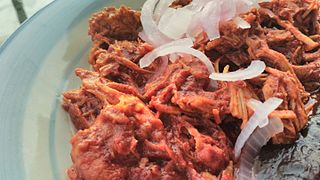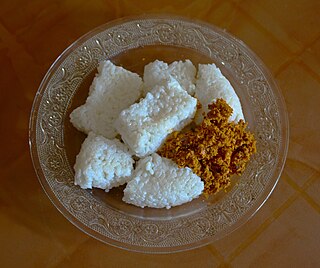
Cooking bananas are a group of starchy banana cultivars in the genus Musa whose fruits are generally used in cooking. They are not eaten raw and generally starchy. Many cooking bananas are referred to as plantains or 'green bananas'. In botanical usage, the term "plantain" is used only for true plantains, while other starchy cultivars used for cooking are called "cooking bananas". True plantains are cooking cultivars belonging to the AAB group, while cooking bananas are any cooking cultivar belonging to the AAB, AAA, ABB, or BBB groups. The currently accepted scientific name for all such cultivars in these groups is Musa × paradisiaca. Fe'i bananas from the Pacific Islands are often eaten roasted or boiled, and are thus informally referred to as "mountain plantains", but they do not belong to any of the species from which all modern banana cultivars are descended.

A tamale, in Spanish tamal, is a traditional Mesoamerican dish made of masa, a dough made from nixtamalized corn, which is steamed in a corn husk or banana leaves. The wrapping can either be discarded prior to eating or used as a plate. Tamales can be filled with meats, cheeses, fruits, vegetables, herbs, chilies, or any preparation according to taste, and both the filling and the cooking liquid may be seasoned.

Malaysian cuisine consists of cooking traditions and practices found in Malaysia, and reflects the multi-ethnic makeup of its population. The vast majority of Malaysia's population can roughly be divided among three major ethnic groups: Malays, Chinese and Indians. The remainder consists of the indigenous peoples of Sabah and Sarawak in East Malaysia, the Orang Asli of Peninsular Malaysia, the Peranakan and Eurasian creole communities, as well as a significant number of foreign workers and expatriates.

Nasi lemak is a dish originating in Malay cuisine that consists of fragrant rice cooked in coconut milk and pandan leaf. It is commonly found in Malaysia, where it is considered as the national dish. It is also a native dish in neighbouring areas with significant ethnic Malay populations such as Singapore and Southern Thailand. In Indonesia, it can be found in several parts of Sumatra, especially the Malay regions of Riau, Riau Islands and Medan. It is considered an essential dish for a typical Malay-style breakfast. Nasi lemak is featured as a national dish in most of the country's tourism brochures and promotional materials.

Malay cuisine is the traditional food of the ethnic Malays of Southeast Asia, residing in modern-day Malaysia, Indonesia, Singapore, Brunei, Southern Thailand and the Philippines as well as Cocos Islands, Christmas Island, Sri Lanka and South Africa.

Otak-otak is a Southeast Asian fish cake made of ground fish mixed with spices and wrapped in leaf parcels. Otak-otak is traditionally served steamed or grilled, encased within the leaf parcel it is cooked in, and can be eaten solely as a snack or with steamed rice as part of a meal.

A nacatamal is a traditional Nicaraguan dish similar to the tamal and to the hallaca. Nacatamales have been linked to the Nicarao tribes who inhabited western Nicaragua, its name originates from the Nawat language which the Nicarao spoke and translates to 'meat tamale'. During pre-columbian times, the Nicarao were using hunted meats like deer and turkey with ingredients such as tomatoes, achiote and herbs to season and increase the nacatamal's flavor before being wrapped in corn husks and steamed. After Spanish conquest, nacatamales were made with introduced meats like pork. They also evolved to include flavorful ingredients like onions and banana leaves replaced corn husks. The nacatamal is perhaps the most produced within traditional Nicaraguan cuisine and is typically eaten on the weekend, for dinner, or for breakfast; it is usually eaten together with white bread and a caffeinated drink like black coffee, Coca-Cola or Pepsi. It is common to enjoy nacatamales (plural) during special occasions and to invite extended family and neighbors to partake.

Assamese cuisine is the cuisine of the Indian state of Assam. It is a style of cooking that is a confluence of cooking habits of the hills that favour fermentation and drying as forms of preservation and those from the plains that provide extremely wide variety of fresh vegetables and greens, and an abundance of fish and meat. Both are centred on the main ingredient — rice. It is a mixture of different indigenous styles with considerable regional variations and some external influences. The traditional way of cooking and the cuisine of Assam is very similar to South-East Asian countries such as Thailand, Burma (Myanmar) and others. The cuisine is characterized by very little use of spices, little cooking over fire, and strong flavours due mainly to the use of endemic exotic fruits and vegetables that are either fresh, dried or fermented. Fish is widely used, and birds like duck, pigeon, squab, etc. are very popular, which are often paired with a main vegetable or ingredient; beef used to be eaten before British colonialism, and some continue to do so. Preparations are rarely elaborate. The practice of bhuna, the gentle frying of spices before the addition of the main ingredients so common in Indian cooking, is absent in the cuisine of Assam. The preferred oil for cooking is the pungent mustard oil.

Cochinita pibil is a traditional Yucatec Mayan slow-roasted pork dish from the Yucatán Peninsula. Preparation of traditional cochinita involves marinating the meat in strongly acidic citrus juice, adding annatto seed, which imparts a vivid burnt orange color, and roasting the meat in a píib while it is wrapped in banana leaf.

Peranakan cuisine or Nyonya cuisine comes from the Peranakans, descendants of early Chinese migrants who settled in Penang, Malacca, Singapore and Indonesia, inter-marrying with local Malays. In Baba Malay, a female Peranakan is known as a nonya, and a male Peranakan is known as a baba. The cuisine combines Chinese, Malay, Javanese, South Indian, and other influences.

The cuisine of the Democratic Republic of the Congo and the Republic of the Congo varies widely, representing the food of indigenous people. Cassava, fufu, rice, plantain and potatoes are generally the staple foods eaten with other side dishes.

The banana leaf is the leaf of the banana plant, which may produce up to 40 leaves in a growing cycle. The leaves have a wide range of applications because they are large, flexible, waterproof and decorative. They are used for cooking, wrapping, and food-serving in a wide range of cuisines in tropical and subtropical areas. They are used for decorative and symbolic purposes in numerous Hindu and Buddhist ceremonies. In traditional homebuilding in tropical areas, roofs and fences are made with dry banana-leaf thatch. Bananas and palm leaves were historically the primary writing surfaces in many nations of South and Southeast Asia.

Fish amok or amok trei is a Khmer steamed fish curry (amok) with a mousse-like consistency, considered one of Cambodia's national dishes. Fish amok is believed to have been a royal Khmer dish dating back to the Khmer Empire, although some question it originating in Cambodia.

Coconut rice is a dish prepared by cooking white rice in coconut milk or coconut flakes. As both the coconut and the rice-plant are commonly found in the tropics all around the world, coconut rice too is found in many cultures throughout the world, spanning across the equator from Southeast Asia, the Indian subcontinent, South America, Central America, West Africa, East Africa, the Caribbean and Oceania.

Kiribath is a traditional Sri Lankan dish made from rice. It is prepared by cooking rice with coconut milk, hence this name, and can be considered a form of rice cake or rice pudding. Kiribath is an essential dish in Sri Lankan cuisine. It is very commonly served for breakfast on the first day of each month and also has the added significance of being eaten for any auspicious moment throughout one's lifetime which are marking times of transition. It is one of the more renowned traditional dishes in Sri Lanka.

Pepes is an Indonesian cooking method using banana leaves as food wrappings. The banana-leaf package containing food is secured with lidi seumat and then steamed or grilled on charcoal. This cooking technique allows the rich spice mixture to be compressed against the main ingredients inside the individual banana-leaf package while being cooked and also adds a distinct aroma of cooked or burned banana leaves. Although being cooked simultaneously with food, the banana leaf is a non-edible material and is discarded after consuming the food.

Botok or ꦧꦺꦴꦛꦺꦴꦏ꧀(Bothok) is a traditional Javanese dish made from grated coconut flesh which has been squeezed of its coconut milk, often mixed with other ingredients such as vegetables or fish, and wrapped in banana leaf and steamed. It is commonly found in the Javanese people area of Java Island (Yogyakarta Special Region, Central, and East Java. It has a soft texture like the mozzarella cheese and is usually colored white.

Malaysian Indian cuisine, or the cooking of the ethnic Indian communities in Malaysia, consists of adaptations of authentic dishes from India, as well as original creations inspired by the diverse food culture of Malaysia. Because the vast majority of Malaysia's Indian community are of South Indian descent, and are mostly ethnic Tamils who are descendants of immigrants from a historical region which consists of the modern Indian state of Tamil Nadu and Sri Lanka's Northern Province, much of Malaysian Indian cuisine is predominantly South Indian inspired in character and taste. A typical Malaysian Indian dish is likely to be redolent with curry leaves, whole and powdered spice, and contains fresh coconut in various forms. Ghee is still widely used for cooking, although vegetable oils and refined palm oils are now commonplace in home kitchens. Before a meal it is customary to wash hands as cutlery is often not used while eating, with the exception of a serving spoon for each respective dish.

Woku is an Indonesian type of bumbu found in Manado cuisine of North Sulawesi, Indonesia.

Ikan bakar is an Indonesian and Malay dish, prepared with charcoal-grilled fish or other forms of seafood. Ikan bakar literally means "grilled fish" in Indonesian and Malay. Ikan bakar differs from other grilled fish dishes in that it often contains flavorings like bumbu, kecap manis, sambal, and is covered in a banana leaf and cooked on a charcoal fire.




















